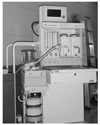Sedation for Pediatric Patients Undergoing MRI
Article information
J Korean Med Assoc. 2010;53(4):343-347
Publication date (electronic) : 2010 April 30
doi :
https://doi.org/10.5124/jkma.2010.53.4.343
Abstract
Magnetic resonance imaging (MRI) requires the patients to remain completely immobile because it is very sensitive to motion artifacts. Therefore, for pediatric patients, deep sedation is required for successful MRI. Since pediatric patients are vulnerable to the complications of sedation, the most important goal is safety. For safe and successful sedation, assigning well trained anesthesiologists or non-anesthesiologist healthcare professionals for the procedure and suitable equipment, monitoring, and medications are necessary.
References
1. Serafini G, Zadra N. Anaesthesia for MRI in the paediatric patient. Curr Opin Anaesthesiol 2008. 21499–503.
2. Hasan RA, Shayevitz JR, Patel V. Deep sedation with propofol for children undergoing ambulatory magnetic resonance imaging of the brain: experience from a pediatric intensive care unit. Pediatr Crit Care Med 2003. 4454–458.
3. Pershad J, Wan J, Anghelescu DL. Comparison of propofol with pentobarbital/midazolam/fentanyl sedation for magnetic resonance imaging of the brain in children. Pediatrics 2007. 120e629–e636.
4. Cho YS, Son YJ, Son ES, Cho YK, Kim YO, Kim CJ, Woo YJ. Effect of chloral hydrate used for pediatric sedation. J Korean Child Neurol Soc 2008. 1678–84.
5. Hannallah RS, Baker SB, Casey W, McGill WA, Broadman LM, Norden JM. Propofol: effective dose and induction characteristics in unpremedicated children. Anesthesiology 1991. 74217–219.
6. Cho JE, Kim WO, Chang DJ, Choi EM, Oh SY, Kil HK. Titrated propofol induction vs. continuous infusion in children under-going magnetic resonance imaging. Acta Anaesthesiol Scand 2010. 54453–457.
Article information Continued
Copyright © 2010 Korean Medical Association




